Please click on PDF below to read all about the Studebaker – Super Lark.
Miscellaneous
- The Studebaker Straight 8 & Indianapolis
Please Click on PDF below to read all about The Studebaker Straight 8 & Indianapolis.
- Paxton-Blown ’64 Studebaker Daytona Keeps Original Owner Smiling.
Dennis Cope’s ’64 Studebaker Daytona Super Lark is a great example of where muscle cars come from.
Sometimes in life you find just the right match. This was the case when Dennis Cope bought his 1964 Studebaker Daytona Super Lark. Since then, the two have never been very far apart. Please read more by clicking on the PDF below.
Paxton-Blown 1964 Studebaker Daytona
- Interesting STUDEBAKER Muscle Car Facts
Please click on PDF below for some Interesting Studebaker Muscle Car Facts.
- SCCQ Concours Run to Linville – Saturday 10th September, 2022
The Club Run for the 2022 Show & Shine was a run from Old Petrie Town through Mount Mee to the Linville Hotel for lunch.
This run was a repeat of the 2021 run, which the club repeated despite the distance required. The members who attended last year gave the trip a very good review and those members who had missed this run were keen to do it for the first time.
The Saturday gave us perfect weather for a run in the country and the scenery along the way was as good as had been promised. On reaching our destination we meet several members who had come from different directions to catch up for lunch.
We were all made very welcome by the landlords, Tracey Driver and Tanya Grimward. The sisters were very sociable and we all felt right at home in their company. The food arrived promptly and was served in generous quantities.
Catching the next day, we all agreed the Linville Hotel had done us proud and the quality of the meals and service provided certainly justified the extra kilometres required to get to Linville. The SCCQ would certainly recommend the hotel to any clubs looking for pleasant drive to a good destination. Please click on link below for information on the Linville Hotel.
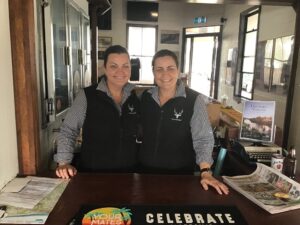
The owners of the Linville Hotel – Tracey Driver & Tanya Grimward.
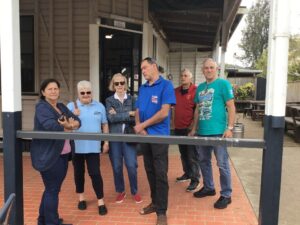
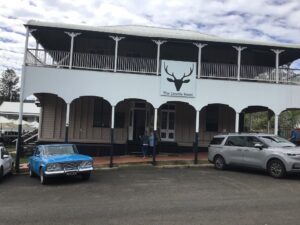
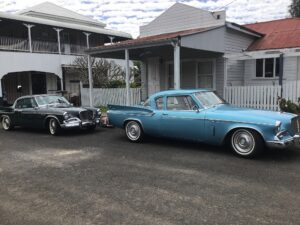

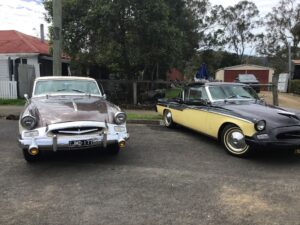
- SCCQ – Visit to Seventh Day Adventist Aged Care Home – 21st September, 2022
Display and Chat Seventh Day Adventist Nursing Home Victoria Point
The club repeated our visit last year to the aged care facility at Victoria Point.
This is a high care section of the facility and a static display in a covered car park is the most practical way to display the cars.
Space is limited, so five cars was enough to provide a focal point for chats over a cup of tea or coffee and biscuits.
Amongst the attendees was a spritely gentleman who informed us that he was 100.8 years old. His maths is still better than mine.
The cars bring back memories that are associated with cars of this vintage and older when they were family transport.
The club is looking at adding a couple of similar facilities that are geographically spread around Brisbane with a target of a minimum of three such visits per calendar year.
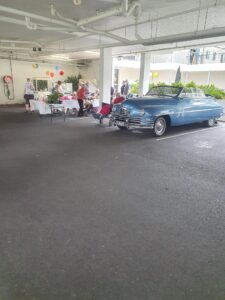

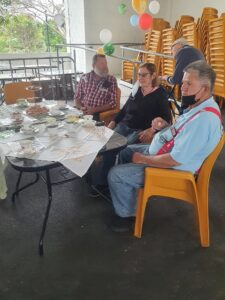
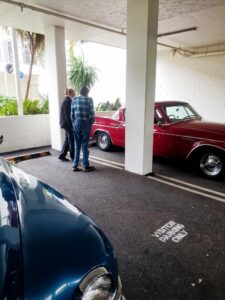
- SCCQ Show & Shine Presentations held on Sunday 11th September, 2022
Studebaker State Meet 2022 Concours Results
A very good turn out from club members to Old Petrie Town for this event on a perfect spring day.
We were located around the Rotunda, scene of last year’s event.
The shift to Sunday from Saturday ensured that a sizeable number of people who attended the monthly markets were able to enjoy our cars and mix with club members.
The standard of the twenty four attending was very high.
43 – 52 Studebaker or Packard 1949 Packard convertible – Bill Beverley
53 – 58 Studebaker or Packard 1955 Speedster – Jim Dack
Commercial 1962 Champ utility – Dave Lucas
Avanti 1964 Avanti – Lyndon Sanders
Hawk 1955 Speedster – John Cosgrove
GT Hawk 1963 GT Hawk – Gus Trouchet
Lark 1964 Commander – Dick Adsett
Perpetual Trophy 1963 GT Hawk – Jim McKinnon
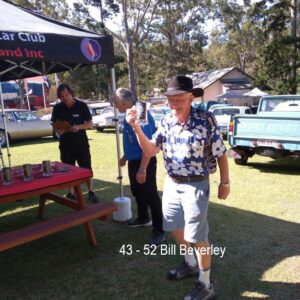
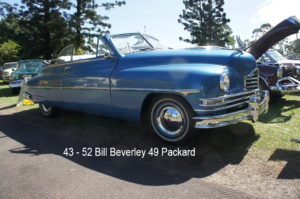
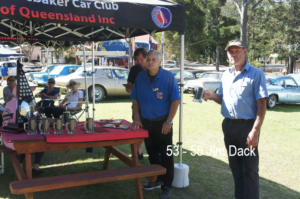
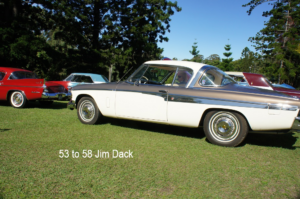

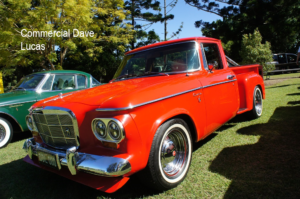
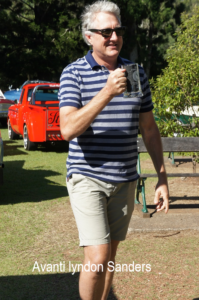
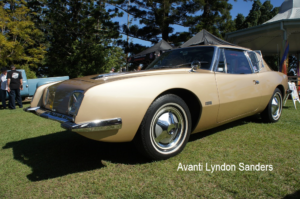

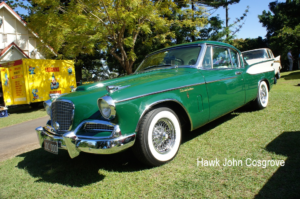
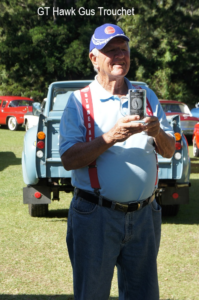
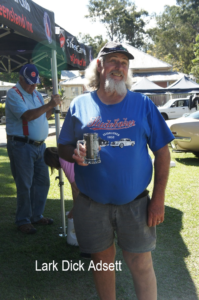
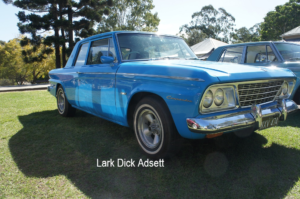
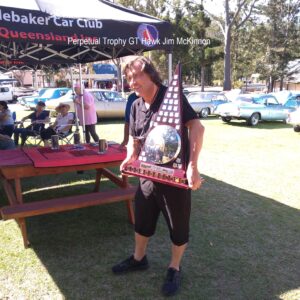
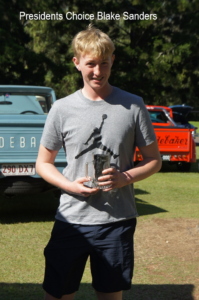
- 1916 Studebaker
1916 Studebaker – Content of Vehicle
In paying respect to our motoring pioneers, Queensland history and the discovery of components that may have a connection to the original race car, this project was tackled as a ‘faithful reconstruction’.
As a ‘replica’ for club registration, this vehicle would only need to meet a rule of five of its seven components being of original manufacture. Anything fitted after that date, would be of replica content. In the sum of its content, a vehicle, if restored from a mechanical shell with no body work, can easily pass 50% of replica contents. However, a ‘faithful reconstruction’ pays attention and effort to accuracy, not sacrificing original parts for replicas.
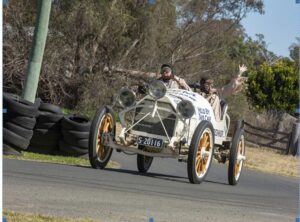
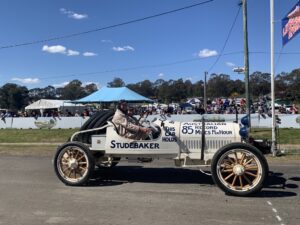
In the year of 1916, Studebaker introduced improved parts into a sports model, which would, sometime later, be adopted through their production range. This ‘faithful reconstruction’ of a race car meets the specifications of the original car.
The transaxle is a six cylinder only, improved build, for the series 17/18 which was the build and same specifications as the race car. Apart from nuts, bolts, bearing, pistons and bushes, all mechanical parts are original 1916 Studebaker manufacture. The crankshaft, flywheel and vibration damper, correct improved specifications, but not 1916 year. The crankshaft is not reground and runs in its original while metal bearings.
The series 17 was produced for a short time at the end of the 1916 production year. Only one was known to exist for racing purposes. Other cars were 16 series and earlier or later 1918 models and onwards.
Many part numbers are shown on the original castings. There are no replacement castings and the following are a list of the cars number which are correct to the 1916 series 17 model.
The Schebler model R is not is not fitted at present as the vehicle is being run with a Zenith.
Cylinder Block 16730 Clutch plate housings 20304 & 17617
Crankcase 16740-1 Transmisssion case 20498
Inlet Manifold 21099 Diff housing cover 26558
Water pump bowl 16728 RH steering box case 17460
Distributor mounting 16747 Steering drop arm 17488
Water outlet housing 16732 Rear spring hangers 16706
Timing cover 16746 Hand controls 17471
Oil pump 16751 Generator EM126
Exhaust manifold 22192? Starter EM154
6 bolt wooden wheels (1916 only)
The 1916 5.8 litre engine, not stamped with an engine number from the factory, indicates that it was not production and was not fitting into a car for sale.
- A World First – Studebaker
A World First
Over a billion tons of corn is harvested annually worldwide with combine harvesters. While the first wheat combine harvester was patented in the US in 1835, it was another 80 years before the combine harvesting of corn was made possible. A Queensland inventor was the first to successfully build one.
From his teenage years, George Iland worked on his future father-in-laws Darling Downs property, maintaining and repairing his Massey Harris No. 2 wheat reaper-thresher. When it came to the corn (maize) crop, he felt there had to be a better way than hand picking corn and he set out to find one.
He is accredited as being the inventor of the corn combine harvester.
George used all the components of an accident damaged Studebaker he had purchased, to propel and drive the machinery of his corn combine harvester. The ‘Big 6’ motor was known to give good torque and power and George would have been seeking the most powerful motor he could find to adequately propel and power his large corn combine harvester. He used a pair of large portable steam engine wheels attached to a truck chassis, and a heavy timber frame for strength and to carry the weight. The Studebaker engine and radiator were mounted on top of the oak timber frame, driving down through the transaxle, connecting to the wheels and drive shafts (seen protruding in the right side of the photo) of his single row picker, elevator, and thresher. The cobs dropped into a bin and the cut up corn stalks were dropped to the ground, small enough to be ploughed under.
This machine is claimed to have been used for only one season in approximately 1920. The processing machinery parts were removed and probably used on a later harvester. Years later, George stated that he bought a Napier car for its motor, with the rest of the car going to the tip.That motor was fitted into another of his harvesters. The Studebaker was the only known self- propelled machine, others being horse drawn. In 1922, George had applied for a patent on his machine. After building seven of his horse drawn and powered machines and taking orders for 42 more, he approached the Eclipse Windmill Co Ltd of Toowoomba, who had been his foundry supplier, to partner and support his enterprise. However, the foundry directors told him that they were too busy on other foundry work! George and his friends were astounded at their short sightedness. No further machines were built. George’s health deteriorated as he had put everything into the venture. Years later he came back to harvesting as a contractor.
The Highfields Pioneering Village displays the only Eclipse machine existing today.
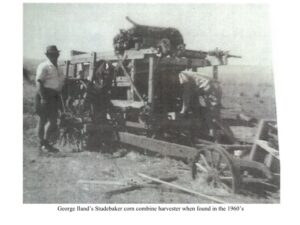
That Studebaker-powered machine sat on the farm for forty years, slowly sinking into the ground. During the 1960’s, all the Studebaker components, including the damaged front axle, radiator and chassis parts, were removed and saved. These parts went under water in the 1974 Brisbane floods.
In the 1990’s, these components formed the ‘faithful reconstruction’ of the Canada Cycle and Motor Agency Qld (CCMA) car as they had prepared it for its last major event, the Sydney to Brisbane record. Sadly, the Studebaker hit the fence, taking out six fence panels during a practice run for the 1919 Mt Coot-Tha hill climb, damaging the chassis and front axle.
Records show that at CCMA Brisbane, a new stock chassis, series 17, was fitted with an improved engine and radiator for race purposes. The radiator was a 1916 larger capacity honeycomb cored that was not supplied in Australian production cars that year. The motor carried no stamped number as it was not for production sales in 1916, but was Studebaker manufactured. The pointed tail body, used in the first land speed record, and removed for the Sydney to Brisbane record, was also made and fitted by CCMA in Brisbane.
Using original components and following the guidelines for a ‘faithful reconstruction’, rather than creating a replica, all parts in our car are original and when necessary, were repaired. None were re-cast or remade. All the 1916 series 17 casting numbers have been listed in a contents list of our vehicle. It is the only known 1916 6 cylinder Studebaker that survives in Australia. This is a similar project to the ‘faithful reconstruction’ of a Canadian police car 40 years ago.
With Australia being a member country of UNESCO and FIVA now representing Australian car enthusiasts, some may wish to read their latest handbook statement of guidelines to keep cars as original as possible. This handbook also includes comments on replicas, mentioning that there will be differing opinions.
Any further information would be appreciated. Gavin Mutton
- Shannons Leyburn Sprints – A Monumental Win
A MONUMENTAL WIN AT RECORD BREAKING LEYBURN SPRINTS
Tuesday 23 August 2022
https://motorsport.org.au/media/news/2022/08/23/a-monumental-win-at-record-breaking-leyburn-sprints
Photos: Trapnell Creations
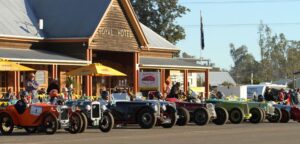
Dean Amos has claimed an emotional seventh outright trophy at the 26th edition of the Historic Leyburn Sprints.
With more than 220 competitors taking part in the event celebrating the 1949 running of the Australian Grand Prix in Leyburn, Amos put on a strong performance around the one-kilometre street circuit, defeating long-time rival and 2021 winner Warwick Hutchinson by just over seven tenths.
It was a significant victory for Amos who earlier this year lost both his home and car tuning business in the devastating Lismore floods.
Thankfully, he was able to save his car before water levels rose in his workshop making his victory all the more special.
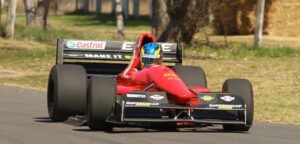
“I wasn’t going to lose the car. Because of Covid issues I haven’t been to Leyburn since 2019, so it was great to save the car and come back this year and win with all my family here to see it,” Amos said.
While Amos added to his current standing record as the most successful outright Sprints competitor with seven wins, the event itself enjoyed a few records with the 2022 Historic Leyburn Sprints attracted record numbers both on and off the track.
The entry list of 221 entries in the time trials was the highest ever entered edition of its growing history, while it was the one of the biggest crowds in the event’s history.
President of the community organising committee, Tricia Chant was thrilled with the weekend.
“We haven’t finished counting all the attendance categories as of Monday morning, but it was definitely a huge crowd, especially on Saturday,” Chant said.
In addition to the racing action, attractions both on and off the track kept the crowd busy, including a vintage van display and the Shannons Show ‘n’ Shine.
Michael Robinson’s restored 1958 FE Holden Special won Best Car in the Shannons Show ‘n’ Shine competition, which attracted more than 60 entries. Tony Sullivan took out the win for best Van and Tow vehicle with a 1969 Olympic Riviera towed by a 1960 Chevrolet El Camino ute painted in matching pastel green.
On track, the 1971 Mazda R100 Coupe driven by Mathew Clift was the fastest sprints in the Historic category, his time of 50.368 seconds securing 17th overall.
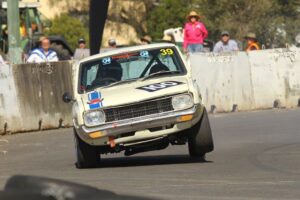 Fans on both days were also treated to special parade laps by two cars that raced together 106 years ago for the Australian Land Speed Record, a 1912 Willys Overland and 1916 Studebaker Six. Although the cars didn’t reach the same speeds back in the day, fans were still left highly impressed by the spectacle.
Fans on both days were also treated to special parade laps by two cars that raced together 106 years ago for the Australian Land Speed Record, a 1912 Willys Overland and 1916 Studebaker Six. Although the cars didn’t reach the same speeds back in the day, fans were still left highly impressed by the spectacle. 
The event was officially launched on Saturday by Southern Downs regional council Mayor, Cr Vic Pennisi said the Sprints were a popular annual tourist attraction for the Southern Downs region and generated a valuable contribution to the local economy.
The 27th running of the Historic Leyburn Sprints is scheduled to take place on the 19-20 August 2023.

